
1
RVBS Quick Start Manual
Content
General installation considerations
Frequently used parameters
Motor parameters
Configuration with digital input
Configuration with analog input
Alarms
Keypad user guide

2
Power supply
voltage
Single-phase
200V
Secure the inverter to the mounting base with
4 screws or bolts (M3) so that the RVBS
Heatsink is on the top side. Tighten those
screws or bolts perpendicular to the
mounting base. (Maximum torque is 0.6N∙m)
Do not mount the inverter upside down or
horizontally. Doing so will reduce the heat
dissipation efficiency of the inverter and
cause the overheat protection function to
operate, so the inverter will not run.
General installation considerations
Installation – Mounting
Installation - Wire size
Nominal applied
motor (kW)
Inverter type
Recommended wire size (mm2)
Main circuit:
input: [L1/L, L2/N]
output:
[U/T1,V/T2,W/T3]
Earth : [PE] Braking
Control circuit
Alarm: [ALM_A,
ALM_B, ALM_C]
Digital
input
Analog
input
0.55
RVBS120055F
1.5(1.5) mm2
0.5mm
0.75
RVBS120075F
*Bare wire length: 8~9mm

3
Installation – EMC
Power supply
voltage
Applicable motor
rating (kW)
Inverter type
Rated Current(A)
of MCCB (w/o
ACR)
Single- phase 200V
0.55
RVBS120055F
10
0.75
RVBS120075F
15
Note 1: Pass the EMC filter input wires (shielded cable and grounding wire in a bundle) through
the ferrite bead core for reducing radio noise two times.
Note 2: Pass the EMC filter output wires (shielded cable and grounding wire in a bundle)
through the ferrite bead core for reducing radio noise two times.
Note 3: Connect the shielding layer of the shielded cable to the motor and panel electrically
and ground the motor and panel.
RVBS

4
Frequently used parameters
Function
Code
Name
Description
F00
Data Protection
0: Disable both data protection and digital reference
protection
1: Enable data protection and disable digital
reference protection
2: Disable data protection and enable digital
reference protection
3: Enable both data protection and digital reference
protection
F01
Frequency Command 1
0: UP/DOWN keys on keypad Keypad enters
frequency reference data in to F29
1: Analog input
F02
Operation Method
1: Terminal command FWD or REV
2: RUN/STOP keys on keypad (forward)
3: RUN/STOP keys on keypad (reverse)
F21
Motor Sound (Carrier
frequency)
2 to 10
F24
Control Mode Selection
1
0: V/f control with slip compensation inactive
1: Dynamic torque vector control
2: V/f control with slip compensation active
Frequently used parameters – Frequency setting
Function
Code
Name
Description
F03
Maximum Frequency 1
25.0 to 120.0
F13
Frequency Limiter (High)
0.0 to 120.0
F14
Frequency Limiter (Low)
0.0 to 120.0
F18
Starting Frequency1
0.1 to 60.0
F20
Stop Frequency
0.1 to 60.0
F29
Digital Reference
Frequency
0.0 to 120.0
F13 and F14 specify the upper and lower limits of the output frequency, respectively.
When you change the frequency limiter (High) (F13) in order to raise the reference
frequency, be sure to change the maximum frequency (F03) accordingly.

5
Maintain the following relationship among the data for frequency control: F13 > F14,
F13 > F18, F13 > F20, and F03 > F14. Where, F18 is of the starting frequency and F20
is of the stop frequency. If you specify any wrong data for these function codes, the inverter
may not run the motor at the desired speed or cannot start it normally.
Frequently used parameters – Output voltage setting
Function
Code
Name
Description
F03
Maximum Frequency 1
25.0 to 120.0
F04
Base Frequency 1:
nameplate of the motor
25.0 to 120.0
F05
Rated Voltage at Base
Frequency 1: nameplate of
the motor
0: Output a voltage in proportion to input
voltage
80 to 240: Output an AVR-controlled voltage
F06
Maximum Output Voltage 1
80 to 240: Output an AVR-controlled voltage
Frequently used parameters – Starting, Stop, slope
setting
Function
Code
Name
Description
Example
F03
Maximum
Frequency 1
25.0 to 120.0
100.0
Acc.slope = 100Hz/5.00sec = 20Hz/s
Dec.slope = 100Hz/10.00sec = 10Hz/s
F07
Acceleration
Time 1
0.01 to 655
5.00
F08
Deceleration
Time 1
0.01 to 655
10.00
F18
Starting
Frequency1
0.1 to 60.0
0.5

6
F19
Starting
Frequency1
(Holding time)
0.00 to 10.00
1.00
Inverter outputs from 0.5Hz. After
outputting 0.5Hz for 1 second,
acceleration starts.
F20
Stop Frequency
0.1 to 60.0
0.5
If it reaches 0.5Hz during deceleration, it
outputs 0.5Hz for 2 seconds before
stopping the inverter output.
F23
Stop Frequency
(Holding time)
0.00 to 10.00
2.00
Frequently used parameters – Motor thermal
protection
Function
Code
Name
Description
F09
Motor ETH
Characteristic
1: For a general-purpose motor with shaft-driven cooling
fan
2: For an inverter-driven motor with separately powered
cooling fan
F10
Motor ETH Level
0.00: Disable, 0.01 to 100.0
1 to 135% of the rated current (allowable continuous
drive current) of the motor
F11
Motor ETH Thermal
Time Constant
0.5 to 75.0
The figure shows operating characteristics of the
electronic thermal overload protection when F09 = 1.
The characteristic factors α1 through α3 as well as their
corresponding switching frequencies f2 and f3 vary
with the characteristics of the motor. Also, Actual
Output Current (Continuous) means the detection level
of output current that electronic thermal overload
protection activates above.

7
Frequently used parameters – Restart (flying start)
Frequently used parameters – Current limit
Function
Code
Name
Description
F25
Current Limiter
(Mode selection)
0: Disable (No current limiter works.)
1: Enable at constant speed (Disable during ACC/DEC)
2: Enable during ACC/constant speed operation
F26
Current Limiter
(Level)
20 to 200 (The data is interpreted as the rated output
current of the inverter for 100%.) *2)
Data for F25
Running states that enable the current limiter
During
acceleration
During constant
speed
During
deceleration
0
disable
disable
disable
1
disable
enable
disable
2
enable
enable
disable
F26 specifies the operation level at which the output current limiter becomes activated, in ratio
to the inverter rating.
Note: Since the current limit operation with F25 and F26 is performed by software, it may
cause a delay in control. If you need a quick response, specify a current limit operation by
hardware (H07 = 1) at the same time.
Note: If an excessive load is applied when the current limiter operation level is set extremely
low, the inverter will rapidly lower its output frequency. This may cause an overvoltage trip or
dangerous turnover of the motor rotation due to undershooting

8
Motor parameters
Function
Code
Name
Description
P01
Motor (Rated capacity):
nameplate of the motor
0.01 to 30.00
P02
Motor (Rated current): nameplate
of the motor
0.00 to 100.0
P03
Motor (Auto-tuning)
0: Disable
1: Tune when the motor stops (%R1, %X)
P04~P10: please refer to “2.2.8 Motor parameters” in manual
•Motor parameter(P05(%R1), P06(%X)) is needed when control mode(F24) is “1: Dynamic
torque vector control” or “2: slip compensation control” and when auto torque boost is
activated(F32=2)
•Please perform auto-tuning when motor parameter is needed for application and the following
conditions are met
- The motor to be driven is a non-standard motor
- Cabling between the motor and the inverter is long
- A reactor is inserted between the motor and the inverter
• Auto-tuning sequence
1) power on the inverter with motor connected
2) set P03 to “1”
- Keypad: after setting P03, “Run” button should be pushed.
- Communication (RS485): when P03 is set by 3 via RS485, then inverter will start auto-tuning
without run command
3) inverter will perform auto-tuning by itself
- DC and altered current will be induced to motor. (Normally, it should be over in 35 seconds.)
4) after auto-tuning, P03 will be reset to “0” automatically
• auto-tuning will be stop when a tuning failure, interruption, or abnormal tuning result is
detected during tuning of motor parameters. (Alarm code: 37, Keypad indication: Er7)

9
Configuration via digital input
Digital Input – Function code
Function
Code
Name
Description
E01
Terminal [DI1] Function 1
Selecting function 1 code data assigns the corresponding
function to terminals [DI 1], [DI2] as listed in the manual.
[FWD] and {REV] function can not support logic-inverted
assignment (i.e., 1098, 109 9)
E02
Terminal [DI2] Function 1
Digital Input – value setting
Function code data
Terminal commands assigned
Symbol
Active ON
Active OFF
8
1008
Reset alarm
RST
40
1040
Emergency stop
EST
97
1097
Change motor operation direction
CHD
98
-
Run forward
FWD
99
-
Run reverse
REV
100
-
No choice
NOC
*These functions codes may also switch the logic system between normal and negative to define
how the inverter logic interprets either ON or OFF status of each terminal. The default setting is
normal logic system "Active ON."

10
Configuration via analog input
Analog Input – Function code
• Analog Input Voltage Offset (C10)
- C10 specifies real time editable offset factor for analog input voltage.
• Analog Input Voltage Gain (C11)
- C11 specifies real time editable gain factor for analog input voltage.
• Analog Input Low-pass Filter Gain (C17)
- C17 specifies the number of samplings of filter analog input to help reducing
noise on signal
Function
Code
Name
Description
C10
Analog Input Voltage Offset
-10.0 to 10.0
C11
Analog Input Voltage Gain
0.0 to 200.0
C12
Frequency at Minimum Analog
Input
0.0 to F03 (Maximum Frequency 1)
C13
Frequency at Maximum Analog
Input
0.0 to F03 (Minimum Frequency 1)
C14
Minimum Analog Input Offset
0.0 to 100.0
C15
Maximum Analog Input Offset
0.0 to 100.0
C16
Analog Input Start Frequency
0: C12
1: 0Hz
C17
Analog Input Low-pass Filter Gain
1 to 8
Function
Code
Name
Exemple
F03
Maximum Frequency 1
90Hz
C12
Frequency at Minimum
Analog Input
40Hz
C13
Frequency at Maximum
Analog Input
80Hz
C14
Minimum Analog Input
Offset
1V
C15
Maximum Analog Input
Offset
9V
C16
Analog Input Start
Frequency
1
Analog input
Target frequency
Ain < 1V
0.0Hz
1V <= Ain <=9V
40.0 ~ 80.0 Hz
9V < Ain
80.0Hz
Key
Fout: Output frequency
Fref: Reference frequency

11
Alarm code
Value
Keypad
indication
Description
LED
flashes
1
OC1
Instantaneous over-current (during acceleration
5
2
OC2
Instantaneous over-current (during deceleration)
3
OC3
Instantaneous over-current (during steady state)
6
OU1
Over-voltage (during acceleration)
3
7
OU2
Over-voltage (during deceleration)
8
OU3
Over-voltage (during steady state)
10
LU
Under-voltage
17
OH1
Heatsink overheated
7
22
dbH
Braking resistor overheated
8
23
OL1
Motor overload
25
OLU
Inverter overload
31
Er1
Memory error
Fully ON
33
Er3
CPU error
37
Er7
Tuning error
2
38
Er8
RS-485 communications error
1
46
OPL
Output phase loss
9
51
ErF
Data saving error during under-voltage
1
61
STO
STO activated
10
254
Err
Mock alarm
4

12
Keypad user guide
Keypad Component
Keypad Function

13
Keypad Configuration Steps
To change parameter setting value using RV_Keypad, please refer to the following steps:
RV-Keypad when wiring it to the RVBS
Step 1
Press PRG/RESET to have access to the groups of registers
and use the up and down button to select the group
Step 2
Press FUNC/DATA to access the register and use the UP/DOWN
buttons to select the register to configure
Step 3
Press FUNC/DATA
Select the value using UP/DOWN buttons
Step 4
After changing the value, press FUNC/DATA key to save
-
 1
1
-
 2
2
-
 3
3
-
 4
4
-
 5
5
-
 6
6
-
 7
7
-
 8
8
-
 9
9
-
 10
10
-
 11
11
-
 12
12
-
 13
13
CARLO GAVAZZI RVBS120055FX10 Owner's manual
- Type
- Owner's manual
- This manual is also suitable for
Ask a question and I''ll find the answer in the document
Finding information in a document is now easier with AI
Related papers
Other documents
-
Oriental motor FRN0006C2S-7U User manual
-
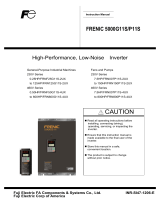 Fuji Bikes FRENIC 5000G11S/P11S User manual
Fuji Bikes FRENIC 5000G11S/P11S User manual
-
Fuji electric Frenic Mega Series User manual
-
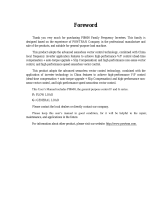 Powtran PI8600 G Series User manual
Powtran PI8600 G Series User manual
-
Genesis KBE2 Operating instructions
-
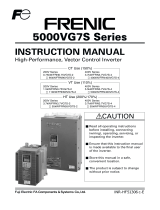 Frenic 5000VG7S Series User manual
Frenic 5000VG7S Series User manual
-
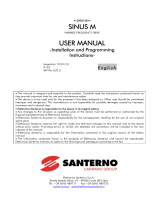 Santerno SINUS M 0017 4T User manual
Santerno SINUS M 0017 4T User manual
-
Hitachi SJ700 User manual
-
Hitachi SJ700B SERIES User manual
-
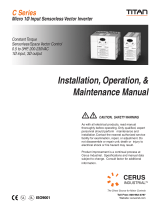 Cerus Industrial Titan CI-000-C2-1P User manual
Cerus Industrial Titan CI-000-C2-1P User manual

















